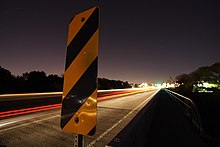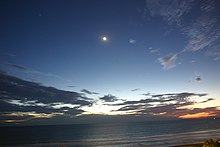Exposure (photography): Difference between revisions
| Line 60: | Line 60: | ||
*[[Night photography]] |
*[[Night photography]] |
||
*[[Long exposure multiple flash photographic technique]] |
*[[Long exposure multiple flash photographic technique]] |
||
*[[Light |
*[[Light painting]] |
||
*[[High dynamic range imaging]] |
*[[High dynamic range imaging]] |
||
Revision as of 23:58, 13 January 2009


In photography, exposure is the total amount of light allowed to fall on the photographic medium (photographic film or image sensor) during the process of taking a photograph. Exposure is measured in lux seconds, and can be computed from exposure value (EV) and scene luminance over a specified area.
Exposure

The exposure for a photograph is determined by the sensitivity of the medium used. For photographic film, sensitivity is referred to as film speed and is measured on a scale published by the International Organization for Standardization (ISO). Faster film requires less exposure and has a higher ISO rating. Exposure is a combination of the length of time and the level of illumination received by the photosensitive material. Exposure time is controlled in a camera by shutter speed and the illumination level by the lens aperture. Slower shutter speeds (exposing the medium for a longer period of time) and greater lens apertures (admitting more light) produce greater exposures.
An approximately correct exposure will be obtained on a sunny day using ISO 100 film, an aperture of f/16 and a shutter speed of 1/100th of a second. This is called the sunny 16 rule: at an aperture of f/16 on a sunny day, a suitable shutter speed will be one over the film speed (or closest equivalent).
A scene can be exposed in many ways, depending on the desired effect a photographer wishes to convey.
Reciprocity
An important principle of exposure is reciprocity. If one exposes the film or sensor for a longer period, a reciprocally smaller aperture is required to reduce the amount of light hitting the film to obtain the same exposure. For example, the photographer may prefer to make his sunny-16 shot at an aperture of f/5.6 (to obtain a shallow depth of field). As f/5.6 is 3 stops 'faster' than f/16, with each stop meaning double the amount of light, a new shutter speed of (1/125)/(2·2·2) = 1/1000 is needed. Once the photographer has determined the exposure, aperture stops can be traded for halvings or doublings of speed, within limits.

The true characteristic of most photographic emulsions is not actually linear, (see sensitometry) but it is close enough over the exposure range of about one second to 1/1000th of a second. Outside of this range, it becomes necessary to increase the exposure from the calculated value to account for this characteristic of the emulsion. This characteristic is known as reciprocity failure. The film manufacturer's data sheets should be consulted to arrive at the correction required as different emulsions have different characteristics.
Digital camera image sensors can also be subject to a form of reciprocity failure.[1]
Determining exposure

The zone system is another method of determining exposure and development combinations to achieve a greater tonality range over conventional methods by varying the contrast of the 'film' to fit the print contrast capability. Digital cameras can achieve similar results (high dynamic range) by combining several different exposures (varying only the shutter speeds) made in quick succession.
Today, most cameras automatically determine the correct exposure at the time of taking a photograph by using a built-in light meter, or multiple point meters interpreted by a built-in computer, see metering mode.
Negative/Print film tends to bias for exposing for the shadow areas (film dislikes being starved of light), with digital favouring exposure for highlights. See latitude below.
Latitude
Latitude is the degree by which one can over, or under expose an image, and still recover an acceptable level of quality from an exposure. Typically negative film has a better ability to record a range of brightness than slide/transparency film or digital. Digital should be considered to be the reverse of print film, with a good latitude in the shadow range, and a narrow one in the highlight area; in contrast to film's large highlight latitude, and narrow shadow latitude. Slide/Transparency film has a narrow latitude in both highlight and shadow areas, requiring greater exposure accuracy.
Negative film's latitude increases somewhat with high ISO material, in contrast digital tends to narrow on latitude with high ISO settings.
Highlights

Areas of a photo where information is lost due to extreme brightness are described as having "blown-out highlights" or "flared highlights".
In digital images this information loss is often irreversible, though small problems can be made less noticeable using photo manipulation software. Recording to RAW format can ameliorate this problem to some degree, as can using a digital camera with a better sensor.
Film can often have areas of extreme overexposure but still record detail in those areas. This information is usually somewhat recoverable when printing or transferring to digital.
A loss of highlights in a photograph is usually undesirable, but in some cases can be considered to "enhance" appeal. Examples include black-and-white photography and portraits with an out-of-focus background.
Blacks
Areas of a photo where information is lost due to extreme darkness are described as "crushed blacks". Digital capture tends to be more tolerant of underexposure, allowing better recovery of shadow detail, than same-ISO negative print film.
Crushed blacks cause loss of detail, but can be used for artistic effect.
See also
- Shutter speed (also called exposure time)
- Film speed
- Exposure value
- Gray card
- Light value
- Multiple exposure
- Sensitometry (and Hurter–Driffield curves)
- Night photography
- Long exposure multiple flash photographic technique
- Light painting
- High dynamic range imaging
References
- ^ David D. Busch (2003). Mastering Digital Photography: The Photographer's Guide to Professional-Quality Digital Photography. Thomson Course Technology. ISBN 1592001149.
